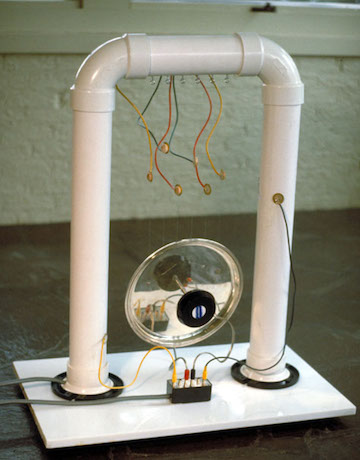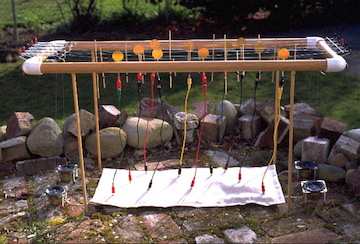 |
||
| The Catacombs of 1995, 2024 update |
Yucatan Sound and Video
Installation - Sculptural Instruments, Video and Sound by Dan Senn |
|
| Introduction to 1995 Event (see video) When I proposed this exhibition to the American Composers Forum, in pursuit of a McKnight Fellowship in early 1995, technology had advanced to where an independent artist, with a working class background (essential), could present a tech-based, interdisciplinary installation in a rough, remote area using an affordable generator, extension cords, monitors from thrift stores, cassette players, a Hi8 camcorder, and some low-tech ingenuity. Today, thirty years later, the video from this time is grainy, the interview fidelity noisy with the post production documentation reflecting the same. The recordings of the cave instruments, however, made back at Shy Anne Studio in Tacoma, WA, and are of CD quality (see playback in upper right hand column of this page). These, made using piezo mics embedded in the instruments, hold up to current standards as do the installation concepts referenced below. In this time of sheepish conformity and social polarization, a cultural event that blends a diverse spectrum of Americans in a cooperative effort, is likely impossible--the cost would be phenomenal. The 1995 Catacombs of Yucatan Sound and Video Installation was presented a half mile from the nearest gravel road on a bluff above my Aunt Marilyn and Uncle Stan's dairy farm in Southeastern Minnesota. The roads here were still dirt in the 1950s, gravel in '95. Patrons were brought to the cave over paddocks in hay wagons that were volunteered by local farmers. But for a handful from La Crosse or the Twin Cities, none of the patrons would've known of John Cage, the fluxus movement or dodecaphony and yet all these were essential to the exhibition. Even so, this one weekend event attracted more than 1500 patrons who patiently waited to descend into this narrow limestone cave once the burial place of American aborigines. By contrast, here in Prague where I live today, the Czech Republic, a glorious old city open to new art and ideas, it is difficult to get 30 informed patrons to attend an event in a 1300 year old church with technology unimaginable 90 years ago. In a lecture from the early 1960s, Erich Fromm commented that "dangerous" art, that promoting individuation in the creators and patrons, may nimbly slips by the censors as did the work of the Czech playwright Václav Havel in Prague in the 1950s and 60s. On it's face, while not in your face, such art may seem absurd, even ridiculous to authorities and yet is embraced (understood) by intellectuals and working people alike as its power results from the angle of dissemination. Havel’s plays mocked the system while flying past the same in a molotov cocktail of paradox. The 1995 Catacombs installations melded fanciful projects 60 years apart—that of a group young people led by Joe Just in rural Minnesota in the 1930s and then another in 1995. With the assistance of today's ubiquitous documentation, like the risky adventure of Joe Just's in the 1930s, human experience is further dislocated in the present as revealed by the interviews given here from those who participated in the original event. The main mover of that time, Joe Just, a skinny guy from Harmony, MN, changed lives, as did the 1995 venture--as did Havel's plays here in Prague. Full frontal attack pisses people off while cementing prejudices, Fromm suggests. It is better to smartly position one’s art if social-political adjustment is also important. The interview clips here, purposefully fragmented, tell the story of the 1934-35 Catacombs venture while giving a vivid glimpse into the extreme ruggedness of The Great Depression from which it arose. The locals attending the 1995 installation recognized these stories, the accents, and faces as they appeared on the video monitors scattered throughout the cave in crevices. These tales were who I was, who the patrons were, the stories embedded amidst edgy art as incongruent as were the memories of cave aborigines to Joe Just and the crudely disturbed graves in 1934. I represented a new Joe with contemporary sensitivites as I cisciously merging cultures and culture anew in a “sensible” updated event. Note: The audio interviews in the middle column were made outdoors at the homes of the subjects in August-September of 1995. They were recorded on the video tracks of a Hi8 Sony Camera and include the incidental sounds of traffic, birds, construction equipment, etc. All the interviewees have passed now but were greatly honored to be part of a new Catacombs project. DS Prague 022324 |
Interview Segments, Audio Click on titles to hear. Paul "Two Men From La Crosse" "So We Hired A Few Boys" "Built A Dance Hall" "Built A Few Cabins" "A Few Rattlesnakes" "A Real Artist" "Blowing Post Holes" "Corn Plough" "Dance Hall Music" "Dug Up Skeletons" "Dust Bowl" "Joe Just & Indians" "Joe's Generator" "Martha Gave Up Too" "Martha Took It Over" "Martha's Hens" "No Way Out" "They Crowded Us" "Things Were Tough" "Wasn't Paying the Bills" "Gwyneth & Quitting" Oneida "Cuz I Never Drove" "Dad Sold Out" "Good Time There" "Lunch Room" "Ma's Heart Attack" "Spunge Cake" "Through 8th Grade" Helen "Joe Just from Harmony" "Joe's Imagination" "$8 Loan" "Bare Hills" "Dust & Dances" "Myrtle Stuck in Mud" "Painted Signs" "Watching Benora" Myrtle 2 "Caged Fox" "Catacombs Song" "Catapillar Paint" "Cave Branches" "Cave Teacher" "Chickadees" "Family Gatherings" "Indian Land" "Joe & Paul" "Looking Over the Valley" "Men In Cabins" "Money Was Scarce" "Pies & Pop" "Snake In Sack" "Singing to Snakes" "They Found Skeletons" Oscar "Bones In a Pile" "Breaking Horses" "Dating" "Bones Dumped Over the Hill" "Hot Water Only" "Hump Backed Flossy" 'Indian Head" "Jeeper Cats" "Manual Labor" "Pussy Foot Doctors" "Served Beer There" "Two Skeletons" "She Was Looked Down On" "The Gaustead Boys" "Two Pollacks" Myrtle 1 "A Straw Hat" "Big Crowds & Fun" "Birds Are Singing" "Up Here Early" "Farming the Hard Way" "We Enjoyed It" "We Walked Up Here" "Lived In Rooster Valley" Gladena "Escort The Girls Out" "Found Husband Dead" "Stuck In Corn Crib" Marilyn "Some People Got Lit up Too" Lower half of Catacombs Installation 1995  Click all photos to enlarge. |
Soundworks
from Installation Instruments
Best played back half volume. Google Chrome works best. Play tracks sequentially, simultaneously
or with staggered, mixed entries. These will sound distorted without headphones, or large air speakers. These may be perform as such in concert.
Shmoos 1
Pendulyre Shmoos 2 Resource Links See Minnesota Composers Forum Article, 1996 See cave documentation video, 1995 (8:18) See Interview Transcript, 1995 See Rochester television news broadcast, 1995 (2:36) See video made from installation materials, 1998 (26:41) *The Highlandville Dance video, 1995, (25:36) ** Catacomb Memory Installations, Germany, 1998-99 ** Catacomb Memory Installations, Tempe, 2000 ** Catacomb Memory Installations, NYC, 2001 Shmoos  Pendulyre  Dan Senn (Prague-Watertown) is an intermedia artist working in music composition and production, kinetic sound sculpture, experimental and documentary film. He has been a professor of music and art in the United States and Australia and travels internationally as a lecturer, performer and installation artist. He lives in Prague where he directs the Echofluxx festivals, and Watertown, Wisconsin, the USA. Dan's work moves freely between expressive extremes and languages depending upon the aesthetic joust at hand. Dan is cofounder of Roulette Intermedium in New York City, Cascadia Composers of Portland Oregon, and the Echofluxx media festivals in Prague. (read more). * The Highlandville Dance video was part of the 1995 exhibition and presented over a color monitor on the dance hall concrete foundation (the actual dance building was razed long ago) a few hundred feet from the cave entrance. It is especially relevant as the music played to this day in Highlandville is the same as presented in 1934-35. BTW, the violin used in the video was once owned by Bill Sherman, a star musician from this region in the 1930s. ** The Catacomb Memories intallations, 1998-2000, were contructed from materials initially used in 1995 at the Catacombs of Yucatan Sound and Video Installation. In the CM versions only one very large, room sized pendulum was presented and controlled digitally rather than using cassette playing subaudio frequencies. The voices (interviews) presented on this page in the middle column were sounded over suspended pieces of paper with piezos attached and used as speakers rather than microphones. |